- Getting around Lijiang. Dont stay in the Old Towns more than 2 days, there is nothing to do. KRISS Oct 9, 2013 05:46
- 2013 Beijing Temple Fair BENNYLAU Feb 26, 2013 03:29
- Malaysian traveling from KUL - LAX vis Shanghai PVG ZATI_DY Jan 3, 2013 20:15
Exploring Kongtong Mountain | 崆峒山
- Views: 9082
- |Vote: 2 0
- |Add to Favorites
- |Recommend to Friends
Mountains in China have long been used as refuges, hideouts, and religious or philosophical havens. Hermits have sought out their silence and seclusion. Poets have written about their aesthetic appeal. Emperors have climbed them to consolidate their power. Buddhists and Taoists have built amongst them their temples and communities, often combining the peace and meditation of spirituality with the precision and discipline of martial arts.
Kongtong Shan, Kongtong Mountain, in Gansu Province, is one of a plethora of lesser-known mountains. Here, temples have sprung up on impossible cliffs and pinnacles from the seeds of Taoist thought blown in on the soft winds of history and legend. That the Yellow Emperor, Taoist deity and original ancestor of all Han Chinese, once came to Kongtong Mountain to seek out the immortal Guangcheng Zi, and ask for his advice on how to rule the country and become more learned. That Dufu, one of China’s greatest poets, wrote of a river filled with blocks of ice so tall it seemed that they might be either Kongtong Mountain, or the pillars of Heaven destroyed. That the Kongtong school of martial arts, with its unique weaponry including staffs and fans was born here.
It’s on such a romantic heritage that the bulk of Kongtong Mountain’s fame rests, and as such Kongtong is not immune from the late 20th century phenomenon of the large Chinese tour group following their megaphone toting guide, with matching hats and flags. Such groups are usually on a high-speed schedule, and follow a specific route, so it’s possible to avoid them by taking different paths, or simply waiting for them to move on. By late afternoon however, their coaches have moved on, and the mountain seems to have drifted back into an earlier age.
Sunbeams punch their way through walls of cloud. Taoist monks emerge, and flasks of hot water are carried; evening beckons and with it the sizzle of water and oil in the wok. Finch-like birds appear on the branches of trees, poking their stubby beaks into pinecones; a male and female take it in turns to feed babies hidden under a tiled roof, identifiable only by their persistent trilling. I sit on a wall in the courtyard of the Heavenly City to watch the sun settle into an understated dusk and wondering if, perhaps, the mountain seekers of old had been inspired by these exact same charms.
Returning to my hotel in the last of the light involves descending the ubiquitous (on Chinese mountains at any rate) steep steps, where I meet an old Buddhist monk making steady progress in his long robes. Something makes me join him; and we walk a while, holding tight to the chains that line the staircase, in silent companionship.
“Where are you from?” he asks, surprisingly, in English. I tell him. His English is limited and we switch to Chinese to continue. I find out he’s 68 years old.
“Do you know anywhere I can sleep?” he asks me.
“Well, there’s a hotel. It’s where I’m staying. But it’s expensive.”
“I have no money.”
He explains that Buddhists and Taoist monks can visit the mountain for free and he is here on pilgrimage to the Buddhist temple. I know that the temple is situated somewhere behind the hotel, and tell him so. We part wordlessly at my hotel; its courtyard a beacon lit with red lamps, and he sweeps off spectre-like into the night.
Kongtong Mountain can still return to that place of old, especially if you have the time to stay overnight. People, and the trappings of the modern world, seem to evaporate, leaving me to nature and the night. I take a moment to remember the stars, which in places like this decorate the dark in unadulterated splendour, before turning in for supper with a couple of the trappings of modern life I’m grateful for: a pot noodle, and a flask of boiling water to “cook” it with.
The hotel is situated on the Central Terrace (中台), halfway up the mountain, with a big car park to accommodate all the tour buses and cars which are forced to stop here. Earlier in the day I climbed from the bottom of the mountain from the East Gate (东门), passing by the Laozi and Mituo Temples on the way. It’s not the most picturesque walk, but if you have the time and the legs for it, there’s nothing more satisfying than the putting of one foot in front of the other to get to the top!
In summer this eastern path is canopied with greenery which gives the impression of walking through a tunnel, and masks the progress of the climb. A flight of steps that has been built around the trees, so that it seems as if they have grown up through the stone, leads out onto a wonderful view of surrounding mountains, and far-off terraces. Railings edge the steps and at the top of each post are the stylised figures of elephants: Indian in design, incongruous. I wonder if perhaps it has a Buddhist connection and is the “precious elephant” representing strength of mind?
The Laozi Temple (太清官) is small; a pine tree and a few scarlet hollyhocks have braved the dry soil, and a bell hangs in the courtyard. Further on and a monk at the Mituo Temple (弥陀寺) brings me a smile and a welcome bowl of cold water to wash my face and hands. The final part of the path follows the road, and leads into the car park; there are stalls selling souvenirs here, a small tourist centre, the hotel and a restaurant that cooks me up a couple of simple dishes, perfect for the appetite I’ve worked up.
For around 2,000 years, successive dynasties have been building temples on Kongtong Mountain, and whilst very little remains of the original structures (most having been destroyed and/or rebuilt), there are still over 40 to be explored. Many of the interior temple walls are covered with old frescoes, murals and examples of trompe l’oeil.
The Heavenly City (皇城), largest of the temple compounds, is reached via the “Ladder to Heaven” (上天梯) and its 378 steep steps, with detours along the way. Thunder Deity Temple (雷祖殿) is on one such detour, and sits on a narrow ridge amidst a cluster of small temples. Although the temple was rebuilt in 1981, it retains some elements of the original stone gate from 1613, where dragons play with pearls, and phoenix fly towards the sun. Inside, the walls are decorated with murals of Thunder Gods riding their clouds, bringing rain, and fighting demons.
Continue ever upwards and all paths lead to the Heavenly City. Built during the early Qing period, and also called the Golden City, the compound perches atop a peak, and consists of several temples, halls, and caves, clustered around the courtyard. One of the caves used to be used for sacrificial offerings to the Taoist figure Wang Lingguan (王灵官). He is a guard and overseer, invoked at rites and ceremonies, and is also responsible for punishing errant Taoists. Now, he is represented by an angry looking statue holding a whip.
Zhen Wu Palace (太和官) is also here, and was built in the Ming dynasty; it’s well known for a collection of stone steles and plaques that were inscribed during the Ming & Qing dynasties.
It’s worth pushing onwards from here to reach Kongtong’s summit, and on the way braving the narrow Bridge to Heaven (通天桥), with spectacular views, over to Heavenly Platform Mountain (天台山). A small temple is in the process of being built on the finger-like peak.
Kongtong’s summit is unremarkable, and flat, but it’s always good to be able to say you’ve climbed to a summit, and the views alone are usually worth it. I grab a chair and an ice-lolly from a happy vendor and sit overlooking the surrounding mountainsides. The flat tops of mountains in every direction are terraced with swirling layers of green and gold – the organic folds of human fields, and the steeper mountainsides where terracing is impossible, bear the pale z-scars of roads. Some golden fields still ripple with as yet unharvested wheat, but elsewhere the sheaves stand like tepees on brown stubbly fields of recently cut stalks. Behind me on the summit, a grand pagoda is being built, and is currently a skeleton of grey stone; the workers are out front on a bed of sand, painstakingly laying and tamping down a complex pattern of bricks to form a path.
The next morning, I head off to the Buddhist Law Wheel Temple (法轮寺) following the path the old monk took the night before. It’s in a beautiful spot, and the grounds are towered over by enormous old conifers whose branches zigzag out against the sky. A group of monks are chanting in the Law Hall, and I am pleased to spot, and exchange smiles, with the old monk – he must have found sanctuary here. An elegant if newish-looking pagoda overlooks the temple, complete with a tree growing from its topmost storey.
I spend a couple more hours looking over a few other small temples scattered around the far side of the mountain, and resisting the temptation to make the descent by cable car. Instead, I opt for a walk down Kongtong’s southern side, to exit at the Heavenly Queen Temple (天母官) by the edge of the blue-green reservoir. The descent, much like the ascent, is a peaceful trudge down stone steps under a canopy of trees, and I meet only a couple of people on the way.
And, truth be told, by the time I reach the Heavenly Queen Temple at the foot of the mountain, I’m all templed-out, and almost don’t bother to look in, but I’m glad that I do. A monk smiles shyly, and tells me this is the oldest Buddhist temple at the site. I feel that it’s quite something to finish in this humble little temple, with its carved pillars, wooden roof, and single ribbon of smoke rising up, whilst the weight of history and legend and rock that is Kongtong Mountain stands guard overhead.
Information (July 2009)
Kongtong Mountain is situated on the outskirts of the town of Pingliang in the east of Gansu Province.
Getting There
From: Lanzhou Long Distance Bus Station (兰州长途汽车客运中心)
To: Pingliang East Bus Station (平凉东站)
Cost: ¥82
Journey Time: 6 hours
Accommodation in Pingliang
When I was there, because I was (still am) a foreigner, I was not allowed to stay in some of the cheaper hotels. After trying a couple and being turned away, I had no choice but to stay at the 4-star Pingliang Hotel. I got a twin room, ensuite, with PC and free internet access, plus a Chinese breakfast for ¥200.
From: Pingliang (平凉)
To: Kongtong Mountain (崆峒山)
Cost: ¥30 (this is a fixed fee regardless of mode of transport, or driver)
By: Taxi or Minivan
Taxis should take you to the East Gate (东门) and will drop you at the car park and ticket office. If you are taking the bus up the mountain then you can buy tickets here, and take the bus from here. However, if you intend to walk up the mountain, you need to exit the car park and continue about 100m down the road to a separate entrance.
Kongtong Mountain (崆峒山)
Entrance Price: ¥120 per person
Bus Ticket: ¥20 per person one-way
The bus takes you to the Central Terrace from where you can explore the main sites (still a great deal of climbing steep steps required from here). It took me about 2 hours to walk up to the Central Terrace, at a leisurely pace, with many photo stops. If you are only spending a day exploring here, I would advise you to take the bus and explore the main sites, rather than do the walk.
Accommodation on the Mountain
Limited accommodation on the mountain, and contrary to what I’ve read in some places, you can’t sleep at any of the temples/monasteries. There is a hotel of sorts, with basic rooms around a courtyard. Communal toilets, used by visitors to the mountains, so you can’t have a shower! They do supply flasks of hot water and bowls though, perfect for soaking your feet after a long day climbing. A twin room was round 400rmb, but I managed to bargain it down to ¥220.
Food on the Mountain
There’s a small restaurant that sells staple fried dishes, noodles and rice – but it closes when visitors leave (5-6pm). The hotel has a small shop complete with pot noodles, beer, water and vacuum-packed snacks if you need to eat something.
Getting down the Mountain
I exited via the South Gate. At the bottom is a couple of kms walk to get to a small carpark (at the head of the reservoir) where minivans will take you back to Pingliang for ¥30.



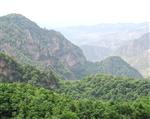
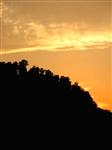
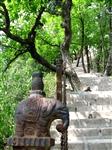
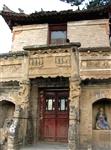
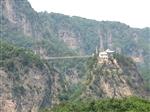
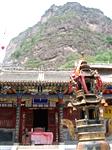
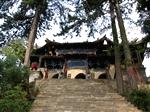
 Copyright © 1998-2025 All rights reserved.
Copyright © 1998-2025 All rights reserved.